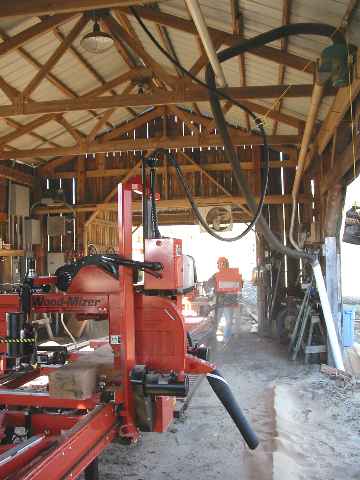Question
Baker sawmill will use 6 gallons every 8 hours. I figure if I ran the mill on gas I would need 48 gallons a week or 120 gallons of gas every month, or 6,240 gals a year - wow!
I think the electric mill will be cheaper to run than the gas. Electric is $70 a 1000. With electric, I won't need to do all the extra work like I would with gas.
The electric company says they will put 3 phase in if I will do the wiring. I told them I would. Question is, what am I getting myself into on the wiring of the sawmill?
Forum Responses
(Sawing and Drying Forum)
As they say, "electricity is penny cheap." Your power unit will be cheaper, too, and quieter. You can get by with less rated HP compared to gas or diesel. Wiring is pretty straightforward. Depending on the type of 3 phase, Delta or Y type, they each have their own motors. If my memory serves me correctly, the Y type isn't found much any more except in older industrial areas. Lots of used motors and switches are available from industrial salvage places, cheap, if that's the route you want to take. Actually, phase converters work pretty efficiently if you don't have 3 phase. It's mostly for starting.
We've been running a Wood-Mizer LT40HDE25 with a roto phase converter for over a year now. Our power company was not so nice - they wanted $40,000 or $360/mo minimum electric bill until the $40,000 was paid off to up our line 1/2 mile to three phase.
I think I checked our electric cost for the 25hp mill, 10hp edger, small dust collector, refrigerator, window fan, etc. and it came to about $3.60/2500 bf. No maintenance cost at all and nothing has failed to need replacing in our first 14 months of use.
Love that 3ph mill. Would have loved having 3ph to the building rather than going to the expense and trouble of the roto phase converter. Even with the added cost of the roto phase, the 3ph mill is less expensive than the diesel engine mill.
37 1/2 HP on the mill, 15 HP on the edger.
For sure, the easiest and most cost-effective way would be to sell your mill and buy a 3ph mill. That's the way we did it. But not everyone thinks that way.
You'd probably still need a main disconnect switch and fusing coming off your power service.
37-1/2 hp - that's a honkin' big motor for a bandmill.
As far as wiring, we lucked out and had a customer that was a certified 3ph electrician come out and wire ours on trade. Only the roto phase conversion wiring was complicated.
The mill was straightforward except to make sure it was wired for the right voltage.
Make sure your cord to the mill is the right type that is flexible and has the right shielding, etc. Have to figure some way for the cord to move back and forth with the sawhead without getting in the way or binding.
Picture notes: Ronk phase converter on left side upper corner of the building with disconnect boxes with fuses, and converter starter motor. (Most of this you would not need.) Power cable cord coming down from the peak of the roof to the motor starter box on the Wood-Mizer mill. There is a nylon rope running from the middle of the power cord to a pulley to the right side and then down to a jug of oil for weight. It pulls the cord to the right to keep it from drooping and from getting tangled in the sawhead. (This is a picture of some of our first cuts and the dust collector is not hooked up.)

Comment from contributor A:
I was the electrical engineer in a large mill for 25 years, and now work for a utility. The 3-phase is most likely the way to go, considering simplicity and economics. The utility will supply 3-phase delta or wye. Motors are wound delta or wye, but either configuration will work with whatever your utility supplies. Used contactors with fused or mcp protection are readily available and should be easy to find, for minimal cost.
Fuel going up in price, downtime for repairs and maintenance, and operator fatigue from listening to that engine revving all day just got to be too much.
I put in a rotary phase generator and there is no looking back. I was using 25-30 dollars of fuel per day alone and now have a bill with all the extras that Ontario Power Generation adds on, of only $60-80 dollars.
And, that includes my dust collectors, moulder, planer. 20 HP 240V 3ph is all the power I need. There is no bogging down, the torque curve is far better, and if it were not for the sound of the blades on the guides, this thing is super quiet. If your mill is stationary, bite the bullet and do the changeover.